to the ends of the earth (er, Africa), part 2
continued from to the ends of the earth (er, Africa), part 1
When the street sign finally read Cape Point Road, everybody became more animated. We definitely were approaching our final destination already.
But first, we were treated with the beautiful meadows of Cape of Good Hope Reserve of the Cape Peninsula Park. Windswept, rugged, with scarcely any thickets of trees, the reserve is an extraordinary terrain of rich and diverse fauna and unique flora. An integral part of the Cape Floral Region Protected Region, the reserve is recognized and protected as a UNESCO World Heritage site for the outstanding diversity, density and endemism of the flora, rated as among the highest in the world.
Collectively characterized as Fynbos vegetation, the flora include proteas (South Africa’s national flower), restios (Cape reeds), ericas (heaths), daisies, irises, lilies, pelargoniums (geraniums) and freesias. The tour guide cum driver bragged that the reserve is more heathland than Scotland, known as the “land of heather”, for the park has about 600 species of flowering heather (Ericaceae). I guess she is right. Scotland, after all, only has 4 and the rest of the world has 26. 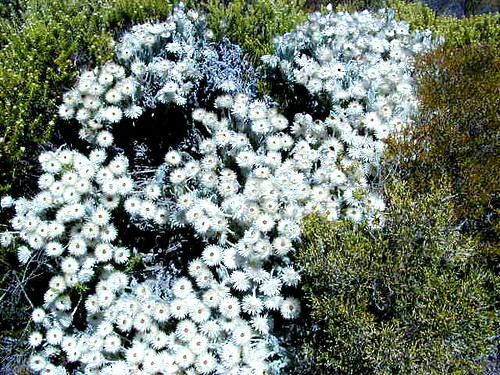
silver heather along the Circular Road near Cape of Good Hope, South Africa
As we pushed towards the Cape of Good Hope, our car made several more stops. Endemic wildlife were roaming around the reserve. We chanced upon wild ostriches. We were told though to be careful with them as they are known to occasionally chase and peck the unsuspecting tourist. When one particularly large ostrich elegantly stooped to drink water from a puddle by the road, I quickly took a snapshot.
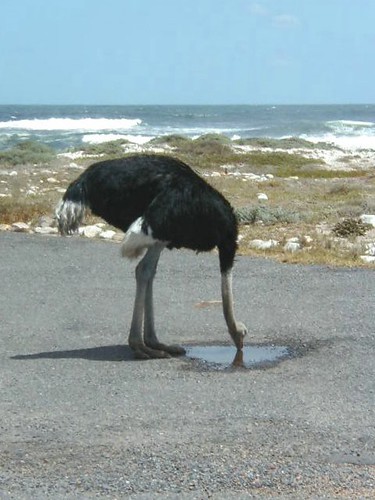
cool relief in a parching hot day on the road, Cape of Good Hope, South Africa
What really are considered more dangerous are the troops of territorial cape baboons. These chacma baboons (Papio ursinus) live in social groups, often numbering near 50. Together, these animals can be aggressively dangerous especially those whose behavior have been modified by frequent feeding by tourists. Well meaning generosity could easily make baboons more dependent on man whom they may see as a source of food. The basic protocol is, when approaced by baboons, seek the protection of your car and roll up the windows. Today it is illegal to feed baboons to ensure that they stay self-reliant in the wild. Sadly, baboons that have been conditioned to receive food from humans may have to be destroyed.
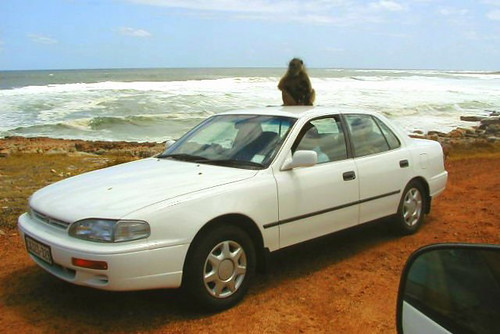
unnerved by the territoriality of one of the baboons, tourists locked themselves inside their car by the road, near Cape of Good Hope
Finally, we came to the end of our journey. Cape of Good Hope, like any cape, is a strip of land projecting into a body of water. But this is no ordinary cape.
There are two false myths associated with the cape.
One, the Cape of Good Hope is the meeting place of the Atlantic and Indian Oceans. This is not true. The real juncture is Cape Agulhas. However, the Cape of Good Hope does witness the meeting of two of earth’s most contrasting water masses- the cold Benguela current (west) and the warm Agulhas current (east).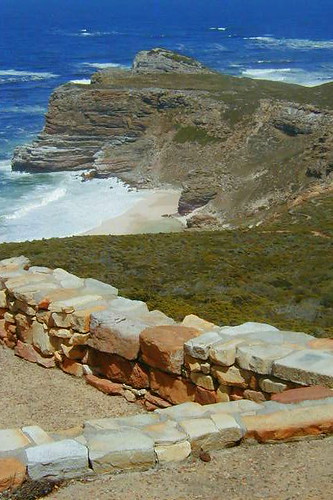
at Capepoint, South Africa
a beach trail at Capepoint
The second misconception is the Cape of Good Hope is the southernmost tip of Africa, hence the misnomer end of the earth. In the Middle Ages, this may impression might have stuck, as explorers coming from the Atlantic Ocean probably saw the protruding cape as the edge of Africa. In reality, the tip, again, is Cape Agulhas.
Notwithstanding the reality checks, the Cape of Good Hope and Capepoint – the two are the west and east end of the Cape Peninsula –are breathtaking. As Sir Francis Drake aptly put in 1580, it is “the most stately thing and the fairest cape we saw in the whole circumference of the earth”.
Among the points of interest at the well-developed cape peninsula are two navigational beacons named after the two Portuguese explorers whose expeditions opened the Cape sea route to the East, Bartholomew Dias and Vasco da Gama. Other attractions include tidal pools, whale watching, shipwrecks, a funicular named after the Flying Dutchman, a restaurant and the ever present visitor center and shop.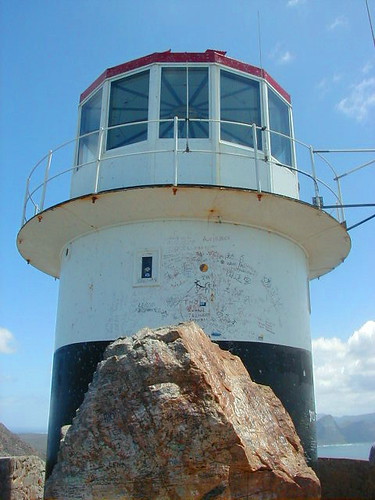
Capepoint Peak lighthouse, South Africa
Winding up the tour, I could not help but do what I almost never do, pose. I am used to traveling alone so by habit, I took up photography not to immortalize my mugshot in personal postcards but to capture the beauty of the scenes that I have been lucky to see, and share them to family and friends. This time though, I gave in and asked a fellow tourist to take a picture of me at the good old Cape of Good Hope.
Why not, when I am already at the end of the earth? (Not really, but that is close enough for me.)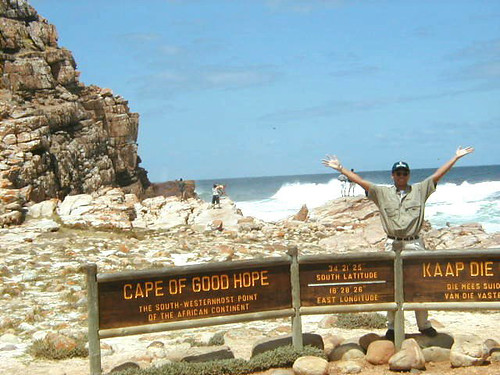
For Cape tours, check out classiccape.co.za. Today, the tour charge is R525/person exclusive of cablecar ticket vs R285 in 2001. Tours depart from Capetown 09:00 and return 17:00.






No comments:
Post a Comment